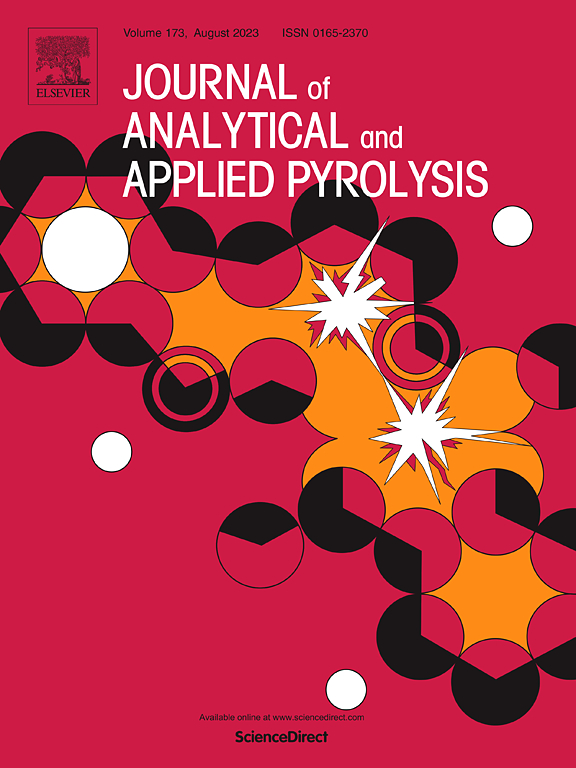Unravelling the molecular significance of Rock-Eval® S2 pyrograms from soil and geological samples
IF 5.8
2区 化学
Q1 CHEMISTRY, ANALYTICAL
引用次数: 0
Abstract
Rock-Eval® pyrolysis is dedicated to rapidly determining the quality and quantity of organic matter (OM) in environmental and geological samples. It has been proposed that detailed examination of S2 pyrograms acquired from a Flame Ionization Detector during the programmed pyrolysis of samples can provide complementary information to classical Rock-Eval® parameters. Previous mathematical deconvolution of the S2 pyrogram has been suggested to semi-quantify distinct thermal fractions that are assumed to be distinct in terms of chemical and/or biological lability. To date, there is no direct molecular support for such an assumption. This work proposes a methodological approach based on coupling a temperature-programmed pyrolyser to a standard mass spectrometer (Py-MS). A set of reference soil samples was analysed. The set was completed by dissolved OM, source rock and coal samples in order to test the relevance of this methodological approach to various OM types. Data analysis was based on Tpeak values defined at temperatures of maximum m/z fragment production during the temperature ramp. These Tpeak values were grouped into clusters of distinct m/z values for which a chemical attribution is proposed owing to an extensive literature survey. For the soil samples, all the pyrolytic fractions described in the literature from mathematical deconvolution of the S2 pyrogram were identified except for the most thermolabile fraction (280–320 °C). Fragments with Tpeak values between 330 and 390 °C were mainly attributed to proteins, lignin and carbohydrates. Tpeak values found in the 391–499 °C range corresponded to m/z fragments attributed to aliphatics, lignin and aromatics while fragments with Tpeak values higher than 480 °C were assigned solely to aromatics. In all samples, these fragments displayed a singular pattern of decreasing m/z with increasing temperature, the significance of which remains to be fully elucidated. This preliminary study provides key methodological guidelines for re-exploring Py-MS applications to disentangle the chemical nature of OM.
从土壤和地质样品中揭示Rock-Eval®S2热像图的分子意义
Rock-Eval®热解是专门用于快速确定环境和地质样品中有机质(OM)的质量和数量。有人提出,在程序热解过程中,通过火焰电离检测器获得的S2热解图的详细检查可以为经典的Rock-Eval®参数提供补充信息。以前的S2热谱数学反褶积已经被建议半量化不同的热组分,这些热组分被认为在化学和/或生物不稳定性方面是不同的。到目前为止,还没有直接的分子证据支持这种假设。这项工作提出了一种基于耦合温度程序化热解到标准质谱仪(Py-MS)的方法方法。对一组参考土壤样品进行了分析。该集由溶解的有机质、烃源岩和煤样品完成,以测试这种方法方法与各种有机质类型的相关性。数据分析基于温度斜坡期间最大m/z碎片产生温度下定义的Tpeak值。这些峰值被分成不同的m/z值簇,其中化学归因是由于广泛的文献调查提出的。对于土壤样品,除了最耐热的部分(280-320°C)外,所有文献中描述的S2热谱数学反褶积的热解馏分都被鉴定出来。Tpeak值在330 ~ 390°C之间的片段主要是蛋白质、木质素和碳水化合物。在391 ~ 499℃范围内发现的峰值对应于脂肪族、木质素和芳香族的m/z片段,而高于480℃的峰值片段仅分配给芳香族。在所有样品中,这些碎片都表现出随温度升高而减小m/z的单一模式,其意义尚待充分阐明。这项初步研究为重新探索Py-MS应用来解开OM的化学性质提供了关键的方法指导。
本文章由计算机程序翻译,如有差异,请以英文原文为准。
求助全文
约1分钟内获得全文
求助全文
来源期刊
CiteScore
9.10
自引率
11.70%
发文量
340
审稿时长
44 days
期刊介绍:
The Journal of Analytical and Applied Pyrolysis (JAAP) is devoted to the publication of papers dealing with innovative applications of pyrolysis processes, the characterization of products related to pyrolysis reactions, and investigations of reaction mechanism. To be considered by JAAP, a manuscript should present significant progress in these topics. The novelty must be satisfactorily argued in the cover letter. A manuscript with a cover letter to the editor not addressing the novelty is likely to be rejected without review.

 求助内容:
求助内容: 应助结果提醒方式:
应助结果提醒方式:


